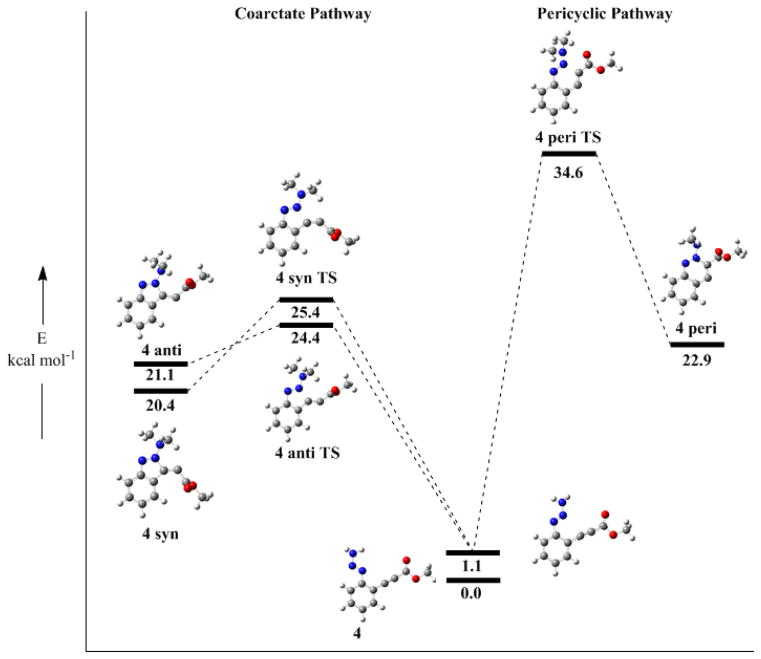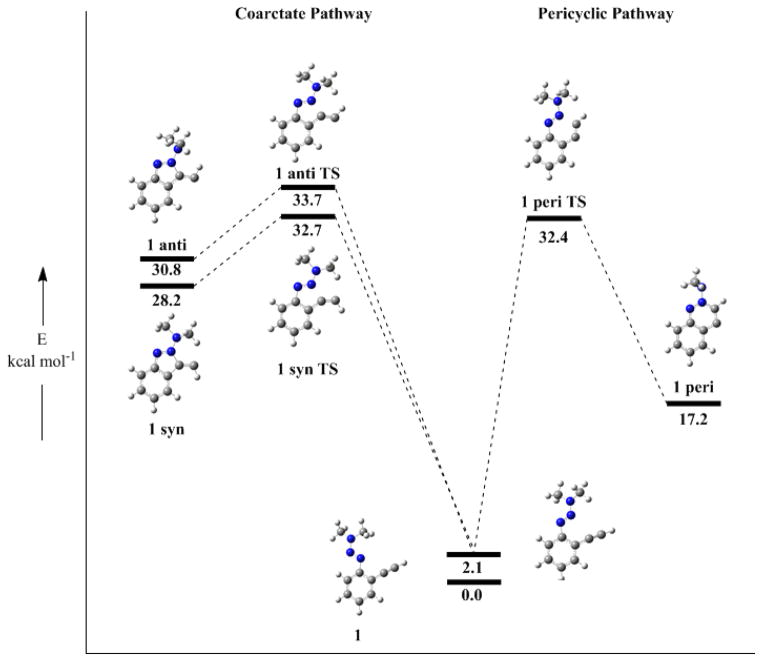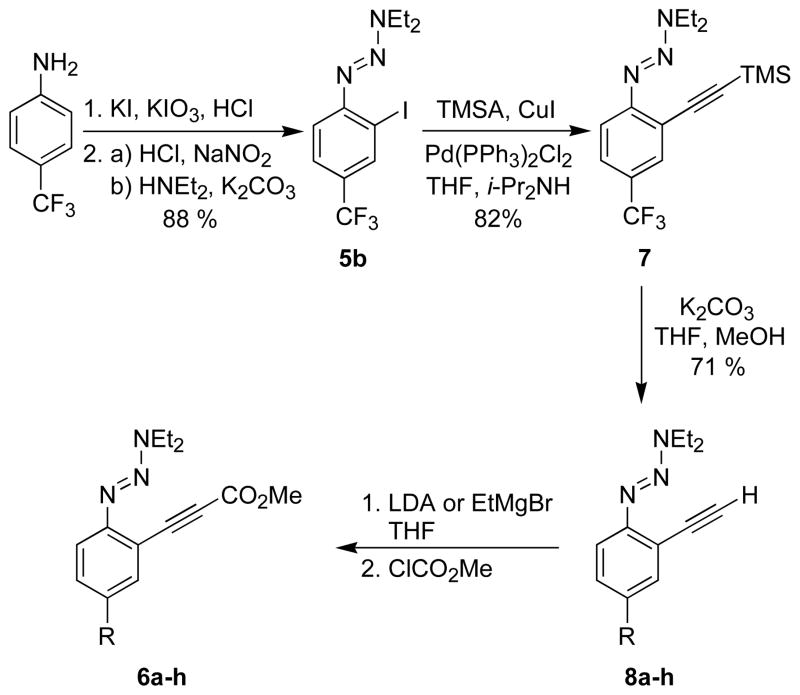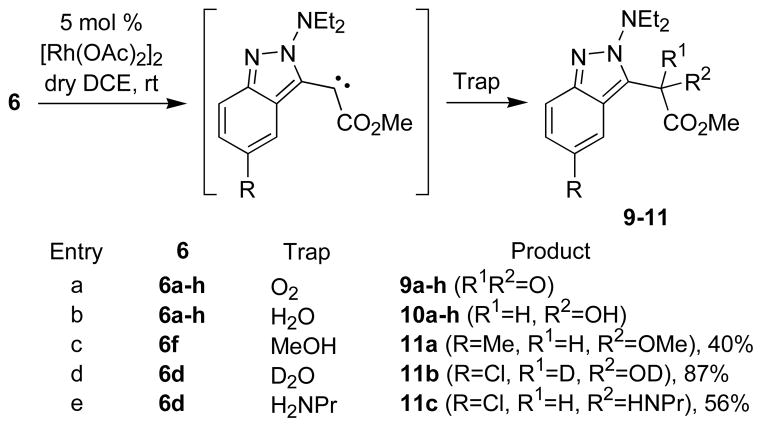Abstract
The synthesis of isoindazoles bearing α-ketoester and α-hydroxyester groups via the coarctate cyclization of ester terminated azo-ene-yne precursors is described. Whereas previous studies on isoindazole formation have shown the reaction to proceed through a kinetic coarctate pathway, functionalization of the terminal acetylene with a methyl ester sufficiently stabilizes the carbene intermediate to make the coarctate cyclization the thermodynamic pathway. Density functional theory (DFT) computations reveal ca. 8–9 kcal mol−1 lower energy transition states for the coarctate pathway compared to the parent system.
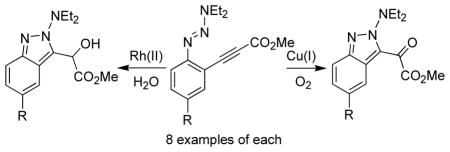
Introduction
Recently there has been considerable interest in the cyclization reactions of ‘ene-ene-yne’ systems (compounds that possess alternating double-single-double-single-triple bonds) to prepare a variety of 5-membered aromatic heterocycles.1 Such heterocyclic compounds have found uses as diverse as incorporation into organic light emitting devices to utilization as pharmacaphores in medicinal applications.2–4 Our laboratory has been studying a subset of ‘ene-ene-yne’ reactions, namely the coarctate cyclization of azo-ene-yne5–8 and azo-ene-nitrile9 systems. Our interest began with the discovery that o-ethynylphenyltriazenes (1) could undergo two different cyclization pathways by simple modification of the reaction conditions (Figure 1).5 Treatment of 1 with CuCl led to the formation of the isoindazole ring system (2) via a carbene/carbenoid intermediate whereas thermolysis at 200 °C led to the formation of cinnoline derivatives (3).
FIGURE 1.

Dual cyclization pathways of azo-ene-yne 1.
The ability of the one precursor to undergo different cyclizations affording two classes of heterocycles in high yield was very intriguing both synthetically and mechanistically. Whereas the formation of 3 occurs via a pericyclic mechanism, the generation of 2 arises from a coarctate cyclization,5 a relatively rare type of concerted reaction mechanism that involves the making and breaking of two bonds at a single atom.10 Coarctate reactions generally entail the making or breaking of five-membered ring systems along with the formation of an exocyclic carbene/carbenoid intermediate, which can be trapped in a number of ways.1,11 Computational analysis of the experimental results confirmed that azo-ene-yne systems do indeed possess dual cyclization pathways, and that the pericyclic pathway is the thermodynamically favored route;5–8 however, the pericyclic pathway is often not observed because of additional, high-energy reactions needed to furnish isolable products.6–8 Based on the previous works, we theorized that by internally stabilizing the carbene intermediate, it might be possible to make the coarctate cyclization the thermodynamic pathway. To that end, incorporation of a methyl ester on the terminus of the azo-ene-yne skeleton should allow for more a facile cyclization reaction and access to functionality not previously available. Herein we present our computational and experimental results which corroborate isoindazole formation via a thermodynamically-favored coarctate reaction.
Results and Discussion
Computational Studies
The cyclization of ester 4 was examined using the Gaussian 0312 suite of programs at the B3LYP level of theory13 and the 6–31G* basis set, which has been found to be a good balance of computational cost and accuracy in our previous cyclization studies.5–8 To reduce the number of conformational degrees of freedom and to save on computational cost, we replaced the NEt2 group with NMe2. In previous studies, we computationally examined the cyclizations of NH2-terminated triazenes; however, with the current system there appeared to be a hydrogen-bonding interaction between the unsubstituted NH2 group and the carbene. A NMe2-substituted triazene eliminated this interaction (Figure 2). To compare this system to the parent terminal alkyne, the corresponding cyclization of 1 had to be reevaluated computationally using a NMe2-terminated triazene (Figure 3).
FIGURE 2.
DFT (B3LYP/6-31G* + ZPE) calculated relative energies of reactants, transitions states, and products for the cyclization of ester 4 to isoindazole carbenes and the cinnoline zwitterion.
FIGURE 3.
DFT (B3LYP/6-31G* + ZPE) calculated relative energies of the reactants, transition states and products for the cyclization of the NMe2 analogue of 1 to isoindazole carbenes and cinnoline zwitterion.
As expected, incorporation of the carbomethoxy group leads to a lower energy pathway for the coarctate cyclization versus the pericyclic cyclization by stabilizing the carbene intermediate. The intermediate energies for the syn and anti products (where syn and anti refer to the orientation of the ester to the benzene ring) were lowered by 8.4 and 9.7 kcal mol−1, respectively. A similar change is seen with the transition states (TS) where the syn and anti TS dropped by 7.3 and 9.3 kcal mol−1, respectively. What is interesting, and unexpected, was that the pericyclic cyclization rose in energy, such that both coarctate intermediates are the lowest energy intermediates between the two pathways; thus, incorporation of the methyl ester into the ene-ene-yne scaffold creates a thermodynamic coarctate cyclization. This is achieved in two ways: (1) by stabilizing the carbene intermediate/TS to give the lower energy pathway, and (2) by destabilizing the pericyclic pathway. In the case of the pericyclic cyclization, the relative intermediate energy raises by 5.7 kcal mol−1 while the TS raises slightly by only 2.2 kcal mol−1. This indicates that we can precisely manipulate the energetics of the cyclization to favor the coarctate pathway, while at the same time disfavoring the pericyclic cyclization. Transition state analysis indicates that the systems are reacting via “true” coarctate and pericyclic mechanisms (see Supporting Information).
Experimental Studies
The initially envisioned route for the cyclization precursors was a modified Sonogashira cross-coupling between known iodotriazene 5a5c and methyl propiolate (Scheme 1); however, this ‘straightforward’ method proved problematic. K2CO3 was used as the base to minimize deleterious 1,4-additions to the alkyne, according to the procedure of Eckert and Ipaktschi.13 Unfortunately, we obtained only low (<20%) yields of the desired product 6a. The addition of a few drops of water to solubilize the base did lead to higher but considerably variable yields; thus, an alternative route was pursued.
SCHEME 1.
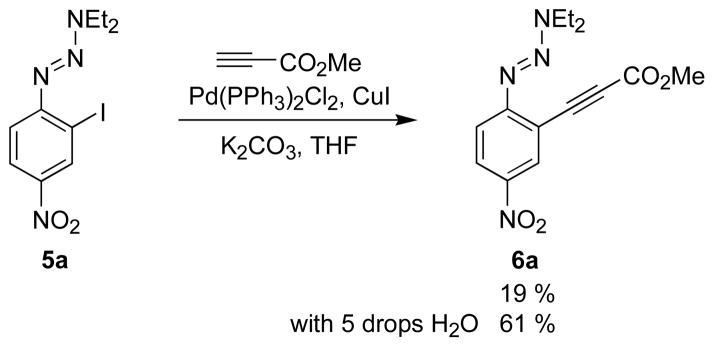
Modified Sonogashira Cross-Coupling of Iodotriazene 5a with Methyl Propiolate
The preferential synthesis of the cyclization precursors is illustrated in Scheme 2 using commercially available p-trifluoromethylaniline. Iodination14 followed by triazene formation furnished arene 5b. Sonogashira cross-coupling with TMSA gave 7, and subsequent protiodesilation afforded azo-ene-yne 8bin 52% overall yield for the four steps. Analogues 8a,c-h were prepared in a similar manner as previously described.5a,c Deprotonation with either LDA (8a,c) or EtMgBr (8b,d-h) in THF followed by addition of methyl chloroformate gave esters 6a-h in 65–85% yields (Table 1).
SCHEME 2.
Synthesis of Azo-Ene-Yne 8b and Esters 6a-h
TABLE 1.
Yields for Ester 6 and Isoindazoles 9 and 10
| entry | R | 6 | 9 | 10 |
|---|---|---|---|---|
| a | NO2 | 66% | 85% | 95% |
| b | CF3 | 68% | 85% | 99% |
| c | CN | 85% | 92% | 92% |
| d | Cl | 82% | 60% | 95% |
| e | H | 75% | 75% | 95% |
| f | Me | 68% | 88% | 90% |
| g | t-Bu | 65% | 88% | 95% |
| h | OMe | 65% | 69% | 88% |
With the desired precursors in hand, we examined several different metal salts to mediate the cyclization, and found that, similar to our previous studies, CuCl proved optimal for the cyclization of 6 to isoindazole-substituted α-ketoesters 9 in 60–90% yield (Scheme 3, Table 1). As the calculations suggested, we observed a remarkable decrease in the reaction time indicative of a lower energy pathway: whereas 1 required heating to 50 °C for 16 h with excess CuCl,5 ester 6 needed only 4 h at 50 °C to cyclize completely to 9. The reaction could also be carried out overnight (14 h) at room temperature. All other copper-mediated conditions (e.g., 5% CuCl, xs CuI, xs Cu(OAc)2, xs CuCl2) failed to give any appreciable amount of 9.
SCHEME 3.

Cyclization of 6 Affording Isoindazoles 9 or 10
Interestingly, when using [Rh(OAc)2]2 as a catalyst, we did not obtain α-ketoester 9. The 1H NMR spectrum of the new material showed two doublets (δ 5.95 and 4.14 ppm for 10a, J = 6.1 Hz) and asymmetric methylene signals of the diethylamino group, the latter result not observed in any of our prior studies. A strong band typical of an O–H stretch suggested the presence of an alcohol group. This was corroborated by shaking the NMR sample (in CDCl3) with D2O, which resulted in collapse of the doublet at 5.95 ppm to a singlet and the loss of the signal at 4.15 ppm. Taken as a whole, the data suggested that the carbene/carbenoid had been trapped with a molecule of water via an O–H insertion to afford α-hydroxyester 10a, a result confirmed by X-ray diffraction (see Supporting Information). While carbenes are known to undergo O–H insertion reactions, this product was unexpected as water was not intentionally added to the reaction. With vigorous attempts to exclude water (flame-dried glassware, distilled solvents, etc.), the formation of 10 could be suppressed and instead 9 was obtained after several days. Whereas the CuCl-mediated cyclization required excess salt, the [Rh(OAc)2]2 cyclizations occurred with as little as 5 mol% catalyst. These reaction conditions were amenable to a range of substituents, from electron withdrawing to electron donating, all with very good yields. Overall the yields tended to be slightly higher with the Rh-catalyzed reaction than in the CuCl-mediated cyclization. Both reactions were very clean, requiring only filtration though a pad of silica to afford pure compounds.
The fact that we could induce cyclization with known carbene/carbenoid stabilizers to afford isoindazoles possessing functionality archetypical of reactions involving carbenes again suggested the presence of such reactive intermediates. In addition to 9 and 10, we successfully trapped the carbene/carbenoid (Scheme 4) via O–H insertion (methanol, 11a), O–D insertion (deuterated water, 11b) and N–H insertion (propylamine, 11c). Attempts to demonstrate carbene/carbenoid intermediacy via a [2+1] cycloaddition with tetramethylethylene, as done in our prior studies, were unsuccessful. This is likely due to the inability of the sterically crowded carbene to approach the tetrasubstituted alkene, as can be inferred from the crystal structure of 10a (see Supporting Information).
SCHEME 4.
Cyclization of 6 and Trapping of the Carbene Intermediate
Conclusion
In summary, functionalization of 1 with a terminal methyl ester moiety results in stabilization of the carbene intermediate and thus leads to a thermodynamic coarctate cyclization. Computations indicate a 12 kcal mol−1 lower TS barrier and experimental evidence corroborates the lower energy pathway. By using ether CuCl or [Rh(OAc)2]2 to induce cyclizations, we were able to trap the isoindazole carbene with molecular oxygen to give α-ketoesters 9a-h or water to afford α-hydroxyesters 10a-h in good to excellent yields. Work on transforming 9 into non-natural amino acids is ongoing.
Experimental Section
General Methods
These have been described previously in reference 5.
General Procedure A: Ester Formation using EtMgBr
Alkyne 8 (1 equiv.) was dissolved in freshly distilled THF (0.1 M) under an Ar atmosphere. EtMgBr (0.98 equiv, 1 M in THF) was added dropwise and the reaction was allowed to stir at room temperature until the evolution of ethane ceased (~2 h). The reaction was then cooled to −78 °C and methyl chloroformate (1.5 equiv.) was added dropwise. The reaction was allowed to stir at −78 °C for 1 h before slowly warming to room temperature. The reaction was quenched with aq. saturated NaHCO3 solution, diluted with EtOAc and the layers separated. The organic layer was then washed with water twice and then brine. The organic layer was dried (MgSO4) and filtered through a short pad of silica. The solvent was removed in vacuo and the residue was purified via column chromatography.
General Procedure B: Ester Formation using LDA
A solution of i-Pr2NH (1.15 equiv.) in freshly distilled THF (1 M based on i-Pr2NH) was cooled to −78 °C under an Ar atmosphere. BuLi (1.1 equiv., 2.5 M in hexanes) was added slowly and the mixture was stirred at −78 °C for 1 h. In a second flask, alkyne 8 (1 equiv.) was dissolved in freshly distilled THF (0.1 M based on 8) and cooled to −78 °C under Ar. The LDA solution was transferred via cannula into the solution 8 and the reaction was stirred at −78 °C for 2 h. With continued cooling at −78 °C, methyl chloroformate (1.5 equiv.) was added and the reaction was stirred at −78 °C for 1 h before slowly warming to room temperature. The reaction was quenched with aq. saturated NaHCO3 solution, diluted with EtOAc and the layers separated. The organic layer was then washed with water twice and then brine. The organic layer was dried (MgSO4) and filtered through a short pad of silica. The solvent was removed in vacuo and the residue was purified via column chromatography.
General Procedure C: CuCl-Mediated Cyclization
1,2-Dichloroethane (0.02 M) was bubbled with O2 for 30 min, after which ester 6 (1 equiv.) and CuCl (10 equiv.) were added. The sealed flask was heated to 50 °C until TLC indicated the complete consumption of 6 (ca. 4 h). Upon completion, the cooled reaction was filtered through a pad of silica eluting with 1:1 hexanes:EtOAc and the solvent was removed in vacuo to afford pure 9.
General Procedure D: [Rh(OAc)2]2-Catalyzed Cyclization
Ester 6 (1 equiv.) and [Rh(OAc)2]2 (5 mol%) were dissolved in 1,2-dichloroethane (0.02 M) and the mixture was stirred at room temperature open to the air. Upon completion (TLC), the reaction was filtered through a pad of silica eluting with 1:1 hexanes:EtOAc and the solvent was removed in vacuo to afford pure 10.
Iodotriazene 5b
4-(Trifluoromethyl)aniline (3.0 g, 18.8 mmol), KIO3 (1.40 g, 6.6 mmol) and KI (2.07 g, 12.5 mmol) were dissolved in water (60 mL) and methanol (10 mL). HCl (1M, 20.5 mL, 20.5 mmol) was added dropwise to the stirred solution over a period of 45 min. Upon complete addition of the HCl, the reaction was stirred for 3 h, diluted with water, and extracted three times with CH2Cl2. The combined organics were washed with aq. NaHSO3 (2x), water (2x) and brine. The organic layer was dried (MgSO4) filtered through a pad of silica and solvent was removed in vacuo to yield 2-iodo-4-(trifluoromethyl)aniline as a tan solid. The product was immediately dissolved in a minimal amount of MeCN and treated with conc. HCl (10 mL, 120 mmol) with stirring. The reaction was cooled to −10 °C and a solution of NaNO2 (2.5 g, 36.2 mmol) in water (15 mL) and MeCN (5 mL) was added slowly such that the internal temperature stayed below 0 °C. Upon completion the mixture was allowed to stir for 45 min at −10 °C. The diazonium solution was transferred via cannula to a stirred quench solution of HNEt2 (18.1 mL, 172 mmol) and K2CO3 (11.9 g, 86.1 mmol) in water (150 mL) and MeCN (50 mL) cooled to −10 °C. After warming to room temperature overnight, the reaction was extracted thrice with ether. The organic layer was dried (MgSO4), filtered through a pad of silica and solvent was removed in vacuo to yield 5b (6.08 g, 88%) as a red oil. 1H NMR (CDCl3) δ 8.06 (d, J = 1.2 Hz, 1H), 7.51 (dd, J = 8.5, 1.2 Hz, 1H), 7.41 (d, J = 8.5 Hz, 1H), 3.83 (q, J = 7.4 Hz, 4H), 1.37 (t, J = 7.2 Hz, 3H), 1.32 (t, J = 7.2 Hz, 3H). 13C NMR (CDCl3) δ 136.2, 136.1, 136.0, 125.7, 125.6, 117.0, 95.7, 49.6, 42.6, 14.4, 10.8. IR (NaCl) ν 2977, 2936, 2875, 1317, 1254, 1121, 1074 cm−1. HRMS (EI+) for C11H13N3F3I: calc 371.01066, found 371.01190.
Ester 6a via Modified Sonogashira Cross-coupling
Iodotriazene 5a (92 mg, 0.26 mmol), Pd(PPh3)2Cl2 (4 mg, 0.005 mmol, 2 mol%), CuI (2 mg, 0.01 mmol, 4 mol%) and K2CO3 (144 mg, 1.04 mmol) were dissolved in freshly distilled THF (2 mL) and water (5 drops) in a screw-top reaction vessel. The solution was purged with Ar for 45 min, then methyl propiolate (0.1 mL, 1.04 mmol) was added. The sealed vessel was heated to 65 °C overnight. Upon cooling, the carbonate filtered and the solvent was removed in vacuo. The crude material was dissolved in ether and the solution was filtered through a pad of silica and then concetrated. The residue was purified by preparative TLC (CH2Cl2) to yield 6a (50 mg, 61%) as a yellow solid. 1H NMR (CDCl3) δ 8.42 (d, J = 2.7 Hz, 1H), 8.18 (dd, J = 9.2, 2.7 Hz, 1H), 7.58 (d, J = 9.2 Hz, 1H), 3.90 (q, J = 7.2 Hz, 4H), 3.84 (s, 3H), 1.40 (t, J = 7.2 Hz, 3H), 1.32 (t, J = 7.2 Hz, 3H). 13C NMR (CDCl3) δ 158.6, 154.2, 143.5, 129.6, 126.2, 117.0, 114.6, 85.1, 83.0, 52.7, 50.2, 43.2, 14.2, 10.6. IR (NaCl) ν 2979, 2225, 1713, 1575, 1516, 1320, 1253, 1083 cm−1. HRMS (EI+) for C14H16N4O4: calc 304.11715, found 304.11908.
Ester 6a via General Procedure B
Triazene 8a was reacted according to General Procedure B. Purification as above afforded 6a (0.054 g, 66%) as a yellow solid whose spectral data were identical with those given above.
Triazene 7
A stirred solution of 5b (6.08 g, 16.4 mmol), CuI, (125 mg, 0.6 mmol, 4 mol%) and Pd(PPh3)2Cl2 (220 mg, 0.3 mmol, 2 mol%) in freshly distilled THF (80 mL) and i-Pr2NH (80 mL) was purged with Ar for 45 min. TMSA (9.3 mL, 65.5 mmol) was added and the reaction was stirred at room temperature until TLC indicated completion. The solvent was then removed in vacuo and the crude solid was dissolved in 9:1 hexanes:CH2Cl2. The mixture was filtered through a pad of silica eluting with 4:1 hexanes:CH2Cl2 and the solvent was removed in vacuo. The crude product was purified by flash chromatography (9:1 hexanes:CH2Cl2) to yield 7 (4.60 g, 82%) as a dark oil. 1H NMR (CDCl3) δ 7.73 (d, J = 1.8 Hz, 1H), 7.50 (d, J = 9.0 Hz, 1H), 7.45 (dd, J= 9.0, 1.8 Hz, 1H), 3.82 (q, J= 7.5 Hz, 4H), 1.33 (m, 6H), 0.25 (s, 9H). 13C NMR (CDCl3) δ 155.1, 130.4, 126.4, 126.0, 125.6, 122.3, 118.2, 116.9, 102.0, 99.4, 49.5, 42.2, 14.4, 10.9, −0.08. IR (NaCl) ν 2965, 2938, 2901, 2160, 2068, 1607, 1456, 1422, 1190 cm−1. HRMS (EI+) for C16H22N3F3Si: calc 341.15351, found 341.15484.
Ethynyltriazene 8b
A solution of 7 (1.4 g, 4.2 mmol) and K2CO3 (5.8 g, 42.3 mmol) in distilled THF (50 mL) and MeOH (10 mL) was stirred at room temperature for 3 h. The excess carbonate was filtered and the solvent was removed in vacuo. The crude material was dissolved in EtOAc and the organic layer was washed with aq. NH4Cl solution (2x), water (3x) and brine (2x). The organic layer was dried (MgSO4), filtered through a pad of silica and the solvent was removed in vacuo to afford 8b (0.811 g, 72%) as a yellow oil which was used without further purification. 1H NMR (CDCl3) 7.74 (s, 1H), 7.49 (m, 2H), 3.83 (q, J = 8.1 Hz, 4H), 3.30 (s, 1H), 1.31 (m, 6H). 13C NMR (CDCl3) 155.4, 130.6, 126.4, 125.9, 125.8, 122.2, 117.1, 81.9, 80.7, 49.4, 42.1, 14.3, 10.6. IR (NaCl) ν 3309, 2979, 2938, 2876, 2111, 1652, 1327, 1253, 1102 1072 cm−1. HRMS (EI+) for C13H14N3F3: calc 269.11398, found 269.11376.
α-Ketoester 9a
Ester 6a was cyclized according to General Procedure C to give 9a (19 mg, 85%) as a yellow solid. 1H NMR (CDCl3) δ 9.18 (d, J = 2.1 Hz, 1H), 8.27 (dd, J = 9.3, 2.1 Hz, 1H), 7.91 (d, J = 9.3 Hz, 1H), 4.00 (s, 3H), 3.33 (q, J = 7.2 Hz, 4H), 0.96 (t, J= 7.2 Hz, 6H). 13C NMR (CDCl3) δ 177.1, 163.7, 147.4, 146.4, 131.7, 121.8, 120.1, 119.8, 119.7, 52.7, 52.3, 11.1. IR (NaCl) ν 3111, 2982, 2926, 2873, 1741, 1663, 1575, 1522, 1456, 1344, 1266, 1038, 1029 cm−1. HRMS (EI+)for C 14H16N4O5: calc 320.11206, found 320.11071.
α-Hydroxyester 10a
Ester 6a was cyclized according to General Procedure D to give 10a (20 mg, 95%) as a tan solid. 1H NMR (CDCl3) δ 8.67 (d, J = 2.4 Hz, 1H), 8.14 (dd, J = 9.9, 2.4 Hz, 1H), 7.73 (d, J = 9.9 Hz, 1H), 5.95 (d, J = 6.0 Hz, 1H), 4.14 (d, J = 6.0 Hz, 1H), 3.80 (s, 3H), 3.51–3.22 (m, 4H), 0.93 (br t, 6H). 13C NMR (CDCl3) δ171.8, 147.2, 143.3, 135.9, 120.8, 118.8, 118.7, 116.0, 64.6, 53.5, 52.5, 52.4, 11.8. IR (NaCl) ν 3477 (br), 3103, 2978, 2922, 2852, 1749, 1627, 1569, 1516, 1334, 1216, 1116, 1080 cm−1. HRMS (EI+) for C14H18N4O5: calc 322.12771, found 322.12795.
Computational Methods
All computations were calculated using the Gaussian 0312 suite of programs at the B3LYP/6-31G* level of theory. All stationary points were confirmed by harmonic frequency analysis and checked for stability for triplet and SCF convergence. The energies of the stationary points were determined, including zero point energies, at the same level of theory. ACID calculations were performed (see Supporting Information) using the previously reported method of Herges et al.16 with the ACID scalar fields interpreted as the density of delocalized electrons.
Supplementary Material
Acknowledgments
We thank the National Science Foundation (CHE-0718242) for support of this research. S.P.M. acknowledges the NSF for an IGERT fellowship (DGE-0549503). N.F. acknowledges the NSF for a summer undergraduate STEP (UCORE) fellowship (DUE-0622620). We thank Dr. Lev Zakharov for obtaining the X-ray structure of 10a. This publication was made possible, in part, by the Mass Spectrometry Facilities and Services Core of the Environmental Health Sciences Center, Oregon State University, grant number P30 ES00210, National Institute ofEnvironmental Health Sciences, National Institutes of Health.
Footnotes
Supporting Information Available: All computational details including cartesian coordinates, total energies and imaginary frequencies for all computed structures as well as transition state analysis; experimental details for 9b-h, 10b-h, 11a-c; copies of 1H and 13C NMR spectra for 5b, 6a-h, 7, 8, 9a-h, 10a-h, 11a-c; X-ray cif file for 10a. This material is available free of charge via the Internet at http://pubs.acs.org.
References
- 1.Shirtcliff LD, McClintock SP, Haley MM. Chem Soc Rev. 2008;37:343–364. doi: 10.1039/b705457m. [DOI] [PubMed] [Google Scholar]
- 2.(a) Katritzky AR, Pozharskii AF. Handbook of Heterocyclic Chemistry. Elsevier Science Ltd; Oxford: 2000. [Google Scholar]; (b) Joule JA, Mills K. Heterocyclic Chemistry. Blackwell; Oxford, U.K: 2000. [Google Scholar]; (c) Li JJ, Gribble GW. Palladium in Heterocyclic Chemistry. Permamon; Amsterdam: 2000. [Google Scholar]; (d) Eicher T, Hauptmann S. The Chemistry of Heterocycles: Structure, Reactions, Syntheses, and Application. Wiley-VCH; Weinheim, Germany: 2003. [Google Scholar]
- 3.(a) Montes VA, Li G, Pohl R, Shinar J, Anzenbacher P., Jr Adv Mater. 2004;16:2001–2003. [Google Scholar]; (b) Chuen CH, Tao YT, Wu FI, Shu CF. App Phys Lett. 2004;85:4609–4611. [Google Scholar]; (c) Wu FI, Su HJ, Shu CF, Luo L, Diau WG, Cheng CH, Duan JP, Lee GH. J Mater Chem. 2005;15:1035–1042. [Google Scholar]
- 4.Inter alia: Yu J, Wearing XZ, Cook JM. J Org Chem. 2005;70:3963–3979. doi: 10.1021/jo040282b.de Angelis M, Stossi F, Carlson KA, Katzenellenbogen BS, Katzenellenbogen JA. J Med Chem. 2005;48:1132–1144. doi: 10.1021/jm049223g.Steffan RJ, Matelan E, Ashwell MA, Moore WJ, Solvible WR, Trybulski E, Chadwick CC, Chippari S, Kenney T, Ecker A, Borger-Marcucci L, Keith JC, Xu Z, Mosyak L, Harnish DC. J Med Chem. 2004;47:6435–6438. doi: 10.1021/jm049194+.Bentley KW. Nat Prod Rep. 2005;22:249–268. doi: 10.1039/b316108k.Tsou HR, Overbeek-Klumpers EG, Hallett WA, Reich MF, Floyd MB, Johnson BD, Michalak RS, Nilakantan R, Discafani C, Golas J, Rabindran SK, Shen R, Shi X, Wang YF, Upeslacis J, Wissner A. J Med Chem. 2005;48:1107–1131. doi: 10.1021/jm040159c.Chauhan PMS, Martins CJA, Horwell DC. Bioorg Med Chem. 2005;13:3513–3518. doi: 10.1016/j.bmc.2005.02.055.Li Z, Yang Q, Qian X. Tetrahedron. 2005;61:8711–8717.
- 5.(a) Kimball DB, Weakley TJR, Herges R, Haley MM. J Am Chem Soc. 2002;124:13463–13473. doi: 10.1021/ja027809r. [DOI] [PubMed] [Google Scholar]; (b) Kimball DB, Herges R, Haley MM. J Am Chem Soc. 2002;124:1572–1573. doi: 10.1021/ja017227u. [DOI] [PubMed] [Google Scholar]; (c) Kimball DB, Weakley TJR, Haley MM. J Org Chem. 2002;67:6395–6405. doi: 10.1021/jo020229s. [DOI] [PubMed] [Google Scholar]
- 6.Shirtcliff LD, Weakley TJR, Haley MM, Kohler F, Herges R. J Org Chem. 2004;69:6979–6985. doi: 10.1021/jo049011r. [DOI] [PubMed] [Google Scholar]
- 7.Shirtcliff LD, Hayes AG, Haley MM, Kohler F, Hess K, Herges R. J Am Chem Soc. 2006;128:9711–9721. doi: 10.1021/ja054547v. [DOI] [PubMed] [Google Scholar]
- 8.Shirtcliff LD, Haley MM, Herges R. J Org Chem. 2007;72:2411–2418. doi: 10.1021/jo0622274. [DOI] [PubMed] [Google Scholar]
- 9.Shirtcliff LD, Rivers J, Haley MM. J Org Chem. 2006;71:6619–6622. doi: 10.1021/jo060965m. [DOI] [PubMed] [Google Scholar]
- 10.(a) Herges R. Angew Chem Int Ed Engl. 1994;33:255–276. [Google Scholar]; (b) Herges R. J Chem Inf Comput Sci. 1994;34:91–102. [Google Scholar]
- 11.McClintock SP, Shirtcliff LD, Haley MM. J Org Chem. 2008;73:8755–8762. doi: 10.1021/jo801390x. [DOI] [PubMed] [Google Scholar]
- 12.Frisch MJ, Trucks GW, Schlegel HB, Scuseria GE, Robb MA, Cheeseman JR, Montgomery JA, Jr, Vreven T, Kudin KN, Burant JC, Millam JM, Iyengar SS, Tomasi J, Barone V, Mennucci B, Cossi M, Scalmani G, Rega N, Petersson GA, Nakatsuji H, Hada M, Ehara M, Toyota K, Fukuda R, Hasegawa J, Ishida M, Nakajima T, Honda Y, Kitao O, Nakai H, Klene M, Li X, Knox JE, Hratchian HP, Cross JB, Adamo C, Jaramillo J, Gomperts R, Stratmann RE, Yazyev O, Austin AJ, Cammi R, Pomelli C, Ochterski JW, Ayala PY, Morokuma K, Voth GA, Salvador P, Dannenberg JJ, Zakrzewski VG, Dapprich S, Daniels AD, Strain MC, Farkas O, Malick DK, Rabuck AD, Raghavachari K, Foresman JB, Ortiz JV, Cui Q, Baboul AG, Clifford S, Cioslowski J, Stefanov BB, Liu G, Liashenko A, Piskorz P, Komaromi I, Martin RL, Fox DJ, Keith T, Al-Laham MA, Peng CY, Nanayakkara A, Challacombe M, Gill PMW, Johnson B, Chen W, Wong MW, Gonzalez C, Pople JA. Gaussian 03, Revision B.04. Gaussian, Inc; Pittsburgh PA: 2003. [Google Scholar]
- 13.(a) Becke AD. J Chem Phys. 1993;98:5648–5652. [Google Scholar]; (b) Lee C, Yang W, Parr RG. Phys Rev B. 1988;37:785–789. doi: 10.1103/physrevb.37.785. [DOI] [PubMed] [Google Scholar]
- 14.Eckert T, Ipaktschi J. Syn Comm. 1998;28:327–335. [Google Scholar]
- 15.Adimurthy S, Ramachandraiah G, Ghosh PK, Bedekar AV. Tetrahedron Lett. 2003;44:5099–5101. [Google Scholar]
- 16.(a) Herges R, Geuenich D. J Phys Chem A. 2001;105:3214–3220. [Google Scholar]; (b) Geuenich D, Hess K, Kohler F, Herges R. Chem Rev. 2005;105:3758–3772. doi: 10.1021/cr0300901. [DOI] [PubMed] [Google Scholar]
Associated Data
This section collects any data citations, data availability statements, or supplementary materials included in this article.



